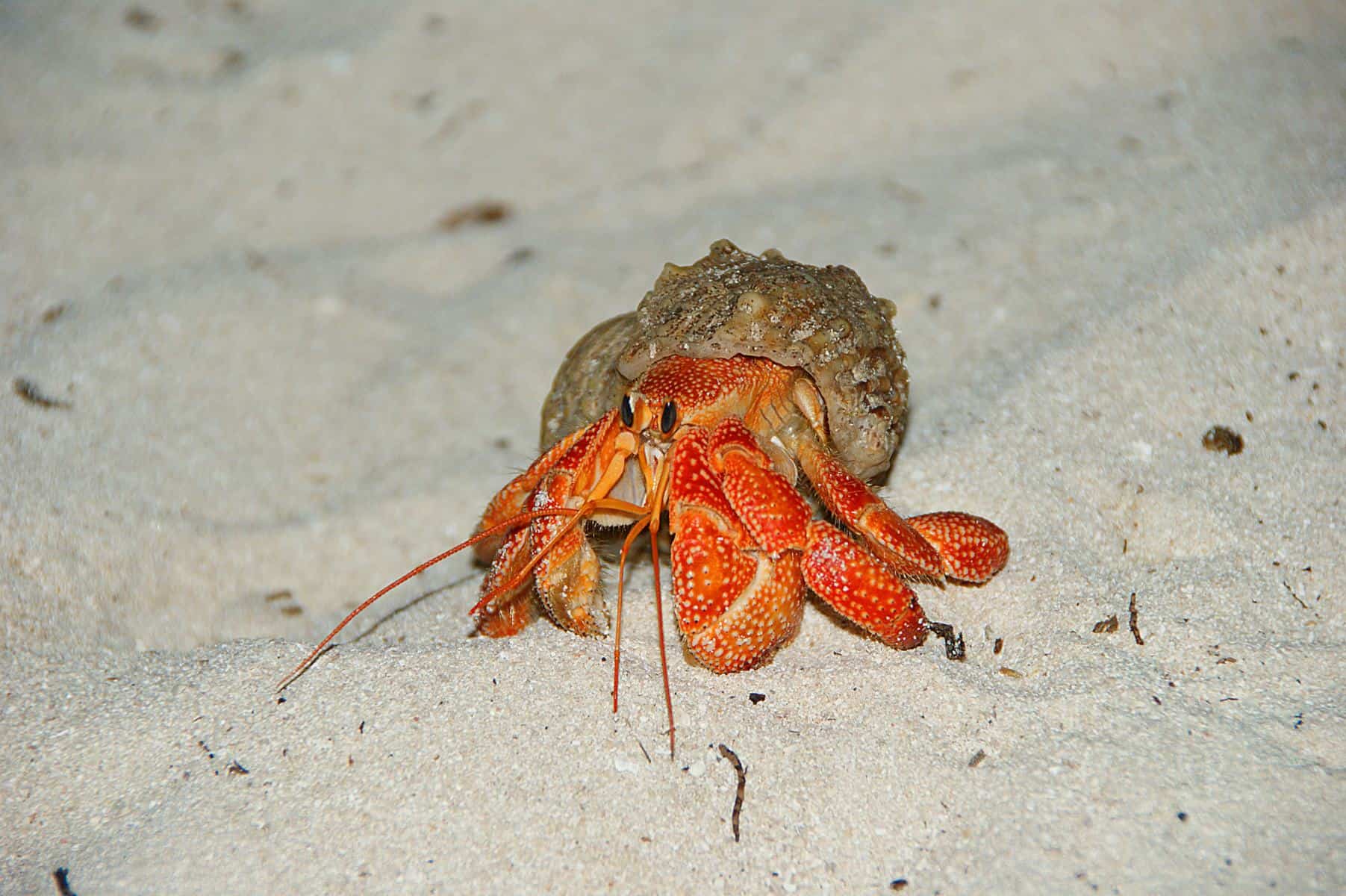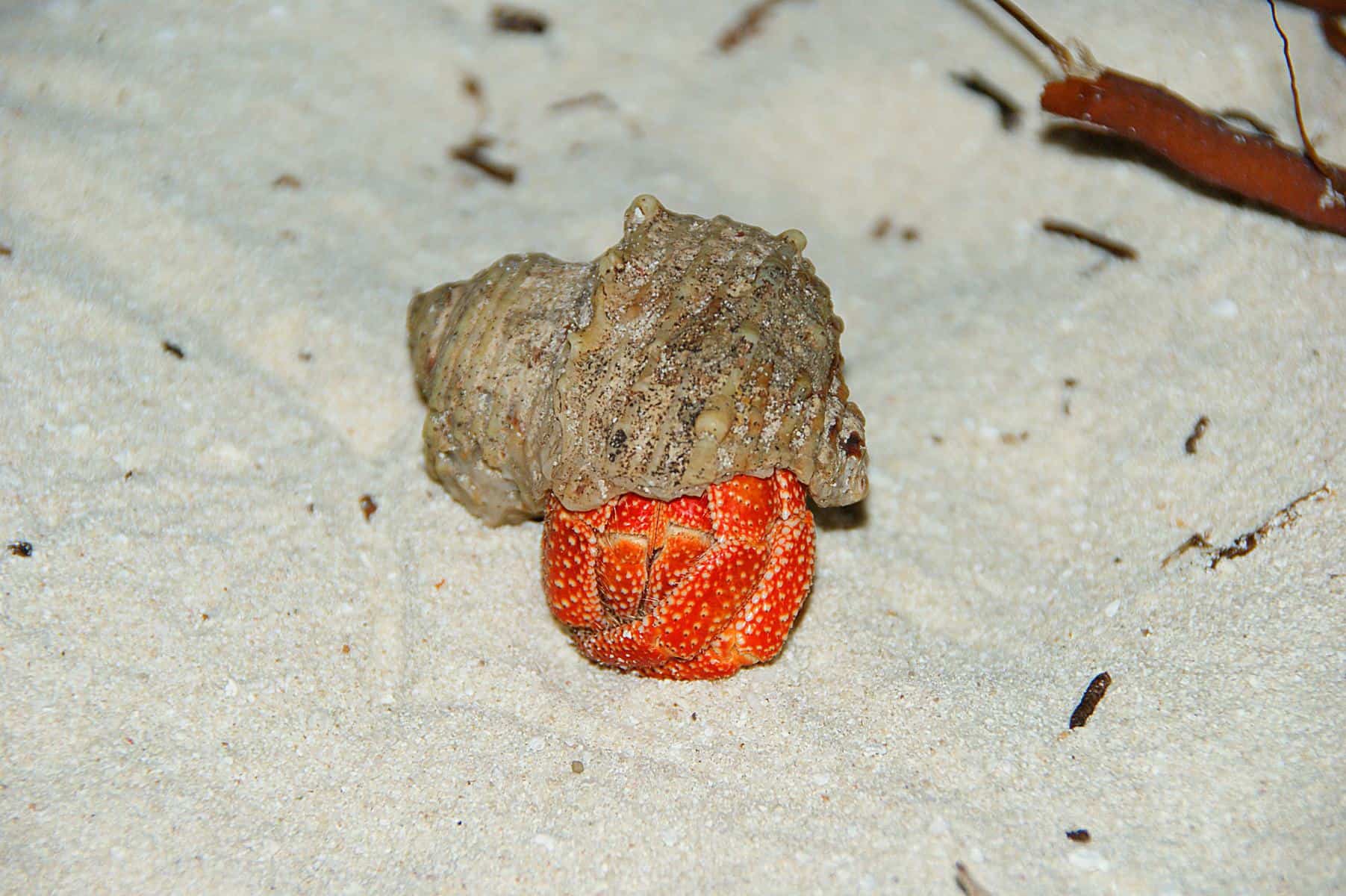[ad_1]
As an aquarium hobbyist, you may already know that there are many species of marine hermit crab available for your saltwater tank. But did you know that only one family of hermit crabs is officially known as land hermit crabs?
These terrestrial crawlers look a lot like the species kept in saltwater aquariums but have a few more specific requirements when it comes to tank requirements and diet. Strawberry hermit crabs are one of the most attractive crabs in this family and are considered one of the more difficult exotic hermit crab species to keep in captivity.
Keep reading to find out everything you need to know about strawberry hermit crabs and how to set up a hermit crab tank of your own!
Name
Coenobita perlatus is commonly known as the strawberry hermit crab. These crabs are part of the Coenobitidaefamily and are terrestrial crabs. In Coenobitidae, there are two genera that house almost 20 different species.
As we’ll discuss later, strawberry hermit crabs are named after their signature red-orange coloration.
Natural habitat

Strawberry hermit crabs originate from the Indo-Pacific with sizeable populations on the Tetiaroa atoll. In general, these crabs can be found on the coast close to saltwater; this species of hermit crab needs a constant source of saltwater to complete several physiological processes. However, they often retreat to the treeline and deeper into the forest to find a supply of freshwater as well.
Many of these large crabs are collected from Indonesia and Madagascar for aquarium distribution.
Identification
The strawberry hermit crab is one of the most easily recognizable species of terrestrial hermit crab as it is named after its deep red, and sometimes orange, coloration. These crabs often have tiny white spots on their exoskeleton that resemble the seeds on strawberry fruits.
They like to inhabit larger gastropod shells and change shells as they continue to molt and grow; a shell serves not only to protect these crabs from predators, but also as a way to hold and preserve water in especially tropical settings where they can easily dry out.
Strawberry hermit crabs actually only molt once or twice a year. During this time, they’re extremely vulnerable to predators and they need to stay under the ground for a couple of months at a time.
How big do strawberry hermit crabs get?
On average, these crabs grow to be about 3 inches (7.6 cm). However, with time, these crabs can grow to be 5-6 inches (12.7-15.2 cm) across!
How long do strawberry hermit crabs live?
In the wild, this species of hermit crab can live a remarkably long time. In fact, it’s not unheard of for them to reach 30 years of age or more.
However, in captivity, it is much more likely for them to only live 3-5 years even with the best care. This is most likely due to the difficulty of replicating their preferred natural environments, which include a constant source of readily available seawater.
Strawberry hermit crab tank requirements
Strawberry hermit crabs are difficult to care for mainly because of space and humidity regulation.
These hermit crabs can get to be big, especially with needing to accommodate for their shell. For a couple of strawberry hermits, it’s recommended to have a tank that is at least 30 inches (76.2 cm) long. Hermit crabs do best on a 3+ inch (7.6+ cm) deep mixture of sand and soil; many hobbyists like to use a combination of EcoEarth products and play sand.
In the wild, these crabs like to retreat to the shaded coastlines and can usually be found up in trees. It is best to provide some natural vines and driftwood for your hermits to be able to explore.
Temperature and humidity regulation
During the day, the aquarium should be heated to around 80-85° F (26.7-29.4° C). At night, the temperature should not be allowed to go under 80° F (26.7° C). While these hermits enjoy tropical conditions, they only actually venture into the direct sunlight for only a few minutes every day; in order to create a sunny area for them in the aquarium, it’s recommended to use a fully controllable basking light.
It is recommended to line parts of the aquarium with heating mats as this will help maintain temperature and humidity; in general, these crabs prefer humidity levels around 60-80% which can be tested with a hygrometer. This will require manual freshwater mistings, or it may be worthwhile to invest in a misting system.
Humidity is key for allowing your strawberry hermit crab to have a successful molt. If ideal conditions are not met, this could sadly result in a dead crab.
Water sources
Strawberry hermit crabs need a source of freshwater and saltwater all the time. You will need shallow freshwater baths and saltwater baths of considerable sizes.
The freshwater bath should be treated with a water conditioner in order to remove any chlorine or chloramine. The saltwater bath will need to be treated as if preparing water for a marine aquarium; this can either be done by purchasing aquarium marine salt and mixing it on your own or getting premixed saltwater. Either way, the water will need a salinity between 1.020-1.028.
Strawberry hermit crabs regularly move between the shore and inland forests where they have readily available sources of both saltwater and freshwater. This water is crucial for successful molting and for keeping their gills wet for breathing.
Strawberry hermit crab behavior

The strawberry hermit crab is more difficult to keep because of its daily migration from the shoreline to the treeline. In the wild, these hermit crabs like to climb trees in groups to eat young leaves and scavenge the beach for easy food.
As with all crabs, the strawberry hermit crab undergoes a molt a couple of times a year in order to grow. During this time, they may burrow into the substrate for considerable amounts of time. Even when not molting, your crab may still bury itself from time to time.
When it’s time for a crab to switch its shell, these hermits will actually form a line based on size so that the smaller crab can take the larger crab’s shell. In the aquarium setting, it is best to always have extra shells available so that the hermit may change whenever it’s ready.
Strawberry hermit crab diet
These hermit crabs get their bright red color from their diet. This species needs foods that are high in carotene which is a natural pigment found in many fruits, vegetables, plants, and animals.
In the wild, strawberry hermits are omnivores. This means that they rely on both meaty- and plant-based foods to meet their dietary needs. As crabs that move between the coastline and more forested areas, they have a large appetite for seaweed, washed up fish, mollusks, and other invertebrates as well as terrestrial plants.
In the aquarium setting, your land hermits will appreciate as much variety as you can give. Foods that are especially high in carotene include carrots, pumpkins, and shrimp.
Other mixed greens, broccoli, cucumber, and mealworms may also be offered to your hermit to keep it interested in eating and to preserve its bright red coloration. It is recommended to always have a high-quality hermit crab pellet on hand for additional variety.
If your strawberry hermit crab does not get enough carotene then it will start to lose its color. When this species does not receive sufficient carotene they tend to lose their color and turn grey and even white.
Can strawberry hermit crabs eat strawberries?
For a species that is named strawberry, can these crabs actually eat this fruit?
Yes! Strawberry crabs can eat strawberries and will gladly do so. In fact, they can eat most fruit as long as it doesn’t have signs of rot.
Conclusion
The strawberry hermit crab (Coenobita perlatus) is one of the more exotic land hermit crabs you can have as a pet. They are cherished for their bright red coloration but can be relatively difficult to keep due to their space, temperature, and humidity demands. They also need to be given a large variety of carotene-rich foods to keep their signature color from fading.
If you have any questions about keeping the strawberry hermit crab, keeping land hermit crabs as pets or have had experience keeping another species, don’t hesitate to leave a comment below!
[ad_2]
Source link
